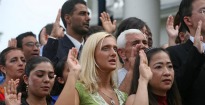U.S. Citizenship Test Riddled With Errors
 Dafna Linzer writes:
Dafna Linzer writes:
Last month, I became an American citizen, a tremendous honor and no easy accomplishment, even for a Canadian. After living here for 12 years, I thought I knew everything. Then I learned how we mint Americans.
After years of steep filing fees and paperwork (including one letter from Homeland Security claiming that my fingerprints had "expired"), it all came down to a test. I passed, and, my fellow Americans, you could, too -- if you don't mind providing answers that you know are wrong.
Friends told me I didn't need to study, the questions weren't that hard. But I wanted to and so for months I lugged around a set of government-issued flashcards, hoping to master the test. I pestered my family and friends to quiz me. Sometimes I quizzed my sources. I learned things (there are 27 amendments to the Constitution) and they learned things (there are 27 amendments to the Constitution). But then we began noticing errors in a number of the questions and answers.
Take Question 36. It asks applicants to name two members of the president's Cabinet. Among the correct answers is "Vice President." The vice president is a cabinet-level officer but he's not a Cabinet member. Cabinet members are unelected heads ofexecutive departments, such as the Defense Department, or the State Department.
The official naturalization test booklet even hints as much: "The president may appoint other government officials to the cabinet but no elected official may serve on the cabinet while in office." Note to Homeland Security: The vice president is elected.
Still, a wonderful press officer in the New York immigration office noted that the White House's own website lists the vice president as a member of the Cabinet. It's still wrong, I explained. I told her that my partner wrote an entire book about the vice president and won a Pulitzer Prize for the stories. I was pretty sure about this one. A parade of constitutional scholars backed me up.
In fact, the Constitution aligns the vice president more closely with the legislative branch as president of the Senate. Not until well into the 20th century did the vice president even attend Cabinet meetings.
Then there is Question 12: What is the "rule of law"?
I showed it to lawyers and law professors. They were stumped.
There are four acceptable answers: "Everyone must follow the law"; "Leaders must obey the law"; "Government must obey the law"; "No one is above the law."
Judge Richard Posner, the constitutional scholar who serves on the U.S. Court of Appeals in Chicago, was unhappy. "These are all incorrect," he wrote me. "The rule of law means that judges decide cases 'without respect of persons,' that is, without considering the social status, attractiveness, etc. of the parties or their lawyers."
So, where do these questions come from?

